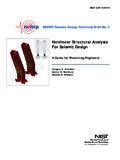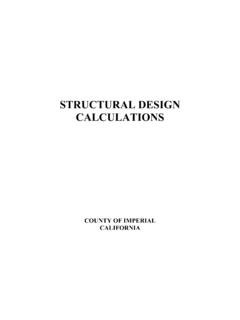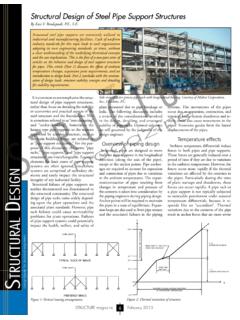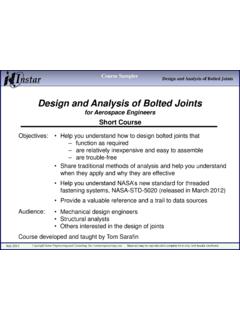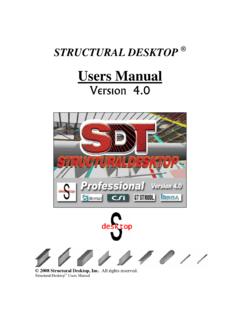Transcription of UNDERWATER INSPECTION CRITERIA - Deep Sea …
1 NAVAL FACILITIES engineering SERVICE CENTERPort Hueneme, California 93043-4370 UNDERWATER INSPECTION CRITERIAByShawn W. KellyNaval Facilities engineering Service Center1100 23rd AvenuePort Hueneme, California 93043-4370 March 1999 Prepared for:California State Lands CommissionMarine Facilities Division330 Golden Shore, Suite 210 Long Beach, California 90802-4246iiiEXECUTIVE SUMMARYThe Marine Facilities Division (MFD) of the California State Lands Commission (CSLC)is in the process of reviewing and formulating various design and INSPECTION CRITERIA forwaterfront facilities. The MFD has a regulatory requirement to require a thorough examination ofeach marine terminal in the State to determine whether the structural integrity of the terminal, theoil transfer operations system, and the safety equipment are designed and being maintained in asafe working condition.
2 To meet this regulatory objective the CSLC has developed a procedurefor performing an in-depth structural and safety system audit of existing marine loading anddischarge terminals located onshore, near-shore, and offshore California. These proceduresapply to pier and wharf terminals, and offshore multi-point mooring marine Naval Facilities engineering Service Center (NFESC) has been tasked to provideinput to the review and formulation of design and INSPECTION CRITERIA for waterfront facilities,based on the Navy s extensive experience and expertise in this area. This document addressesthe UNDERWATER INSPECTION component of the overall effort. This UNDERWATER INSPECTION CRITERIA isintended to provide guidance to the CSLC on the INSPECTION of the UNDERWATER components of amarine oil terminal facility with the intent on identifying structural damage or weaknesses thatmight affect the continued fitness-for-purpose of the OF GENERAL SCOPE OF UNDERWATER INTRODUCTION TO WATERFRONT Berthing Piling.
3 Wharves and Fender Dolphins .. Coastal Protection GENERAL INSPECTION Levels of Planning for INSPECTION .. INSPECTION Frequency .. Documentation of Equipment and Surface Cleaning Tools .. INSPECTION Tools .. Recording Tools .. STEEL STRUCTURES .. Types of Steel Structures .. Deterioration of Steel Abrasion .. Structural Connection Fatigue Foundation OF CONTENTS (continued) Typical INSPECTION UNDERWATER .. Equipment and Tools Required .. Ultrasonic UNDERWATER Magnetic Particle COMPLIANT Types of Compliant Moorings .. Compliant Mooring Anchors .. Deterioration of Fleet Moorings .. Chain-Link Measurements .. Typical INSPECTION INSPECTION Checklist.
4 Cathodic Protection Equipment and Tools Required .. CONCRETE STRUCTURES .. Types of Marine Concrete Structures .. Deterioration of Marine Concrete Corrosion of Reinforcing Freeze/Thaw Abrasion Chemical Deterioration .. Axial Overloading .. Other Deterioration Concrete INSPECTION UNDERWATER .. Visual Level III Nondestructive INSPECTION of OF CONTENTS (continued) Equipment and Tools Required .. Magnetic Rebar Rebound Ultrasonic TIMBER Types of Timber Deterioration of Timber Fungi and Rot Marine Borer and Insect Shrinkage Structural Connection Abrasion Typical INSPECTION UNDERWATER .. Equipment and Tools Required .. STONE MASONRY STRUCTURES.
5 Types of Stone Masonry Structures .. Deterioration of Stone Masonry Typical INSPECTION Equipment and Tools Required .. COASTAL PROTECTION STRUCTURES .. Seawalls .. Jetties .. OF CONTENTS (continued) Rubble-Mound Deterioration of Rubble-Mound Structures .. Typical INSPECTION Equipment and Tools Required .. SYNTHETIC MATERIALS AND COMPONENTS .. Structural Coatings, Patches and Foam-Filled Fenders.. QUAYWALLS .. THE INSPECTION California State Lands Commission's (CSLC) has the following regulatoryrequirement: At least once every three years, the Marine Facilities Division (MFD) shall causeto be carried out a thorough examination of each marine terminal in the state todetermine whether the structural integrity of the terminal, the oil transferoperations system and the safety equipment are designed and being maintained ina safe working condition.
6 To meet this regulatory objective the CSLC has developed a procedure for performing anin-depth structural and safety system audit of existing marine loading and discharge terminalslocated onshore, near-shore and offshore California. These procedures apply to pier and wharfterminals, and offshore multi-point mooring marine terminals. Mooring equipment on the vesselused to secure the vessel to the wharf/pier or offshore multi-point mooring is a part of this auditprocedure, objective of the audit should be prevention as well as cure. In addition to thecorrection of an individual non-conformance item, the audit team should look for improvementsto the safety system or structure, which would prevent its recurrence elsewhere.
7 Ideally, theparticipants in the audit work as a team and the objective of the audit is not only to document andassess the criticality of deficiencies, but also to enhance reliability, safety and structural integrityof the terminal and its audits should compare the facility with the standards and practices used for itsoriginal design and operation. However, it should also be compared against current standardsand those areas where upgrading would provide a significant improvement in safety should beidentified. The purpose of the audit procedure is to:(1)Identify safety system, mechanical, and electrical deficiencies at the marine terminal,(2)Identify structural damage or weaknesses that might affect the continued fitness-for-purpose of the terminal,(3)Advise whether these deficiencies have been properly assessed, and,(4)
8 Advise what steps should be taken to prevent, or minimize these potential UNDERWATER INSPECTION CRITERIA is intended to provide guidance to the CSLC on theinspection of the UNDERWATER components of a marine oil terminal facility with the intent onidentifying structural damage or weaknesses that might affect the continued fitness-for-purposeof the CONSIDERATIONSThe fundamental purpose of any INSPECTION is to provide the information necessary toassess the condition (capacity, safety, and rate of deterioration) of a structure. A waterfrontinspection encompasses the examination of structures such as: piers, pilings, wharves, quaywalls,fender systems, dolphins, dry docks, and coastal protection structures.
9 The usefulness of aninspection depends upon establishing a clear and complete record. Although the level ofinspection will determine the extent of information to be provided, in general the INSPECTION willaddress the following:(a)Identification and description of all major damage and deterioration of the facility.(b)Estimate of the extent of damage and deterioration.(c)Identification of any problems associated with mobilization of equipment, personnel,and materials to accomplish repairs/maintenance.(d)Updated layouts of pile plans (which occasionally differ significantly from thedrawings available at the activity).(e)Documentation of types and extent of marine growth (to help plan future inspections),as well as damage caused by their presence.
10 (f)Water depths at each facility.(g)Water visibility, tidal range, and water current.(h)Information for the database of waterfront facilities and data to assist in planningfuture inspections.(i) Assessment of general physical condition including projected load capacities of thein-water structures of each facility inspected.(j)Recommendations for required maintenance and repair (M&R).(k)Budgetary estimates of costs of this M&R, including examples of the derivation of theestimates.(l)Estimate of expected life of each facility.(m) Recommendations for types and frequencies of future UNDERWATER are several types of inspections, including:(a)Baseline - to obtain data on an uninspected facility. This type involves the greatest pre- INSPECTION effort.
